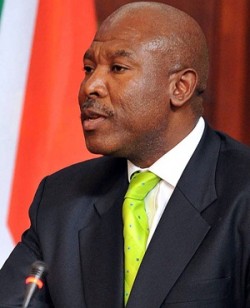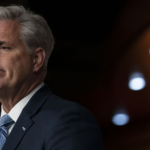
RESTRICTED TO EDITORIAL USE - MANDATORY CREDIT "AFP PHOTO / GOVERNMENT HANDOUT / ELMOND JIYANE" - NO MARKETING NO ADVERTISING CAMPAIGNS - DISTRIBUTED AS A SERVICE TO CLIENTS South Africa's new Deputy Governor of the Reserve Bank Lesetja Kganyago addresses the press in Pretoria on March 25, 2011. AFP PHOTO / GOVERNMENT HAND OUT PHOTO / ELMOND JIYANE
Johannesburg – South African Reserve Bank Governor Lesetja Kganyago moved to restore stability in the economy and cement his inflation-fighting credentials by taking more aggressive action to counter the effects of a plummeting currency.
Policy makers raised the benchmark interest rate by half a percentage point to 6.75% on Thursday, moving away from its gradual approach of tightening in moves of 25 basis points at a time.
Kganyago and Finance Minister Pravin Gordhan have taken on the task of restoring confidence in an economy hit by plunging commodity prices, a series of missteps by President Jacob Zuma last year and the risk of credit-rating downgrades to junk.
The rand plunged 15% against the dollar since the last Monetary Policy Committee meeting, threatening the central bank’s 3% to 6% target.
“This is definitely an attempt at restoring some credibility,” Manisha Morar, an economist at ETM Analytics, said by phone from Johannesburg.
“It sends a message that the bank is willing to act decisively to stabilize the economic environment, especially given the volatility that we’ve seen in the currency.”
“We’ve long felt that higher interest rates, while likely to cause some near-term economic pain, would over the medium to longer term aid in some economic re-balancing,” she said.
The rand’s slide last year was worsened in December when Zuma unexpectedly fired Finance Minister Nhlanhla Nene and replaced him with little-known lawmaker David van Rooyen.
A market backlash that saw the rand plunge to a record low forced Zuma to reverse his decision four days later and appoint Gordhan to a post he had occupied from 2009 to 2014.
The MPC’s decision was in line with the forecasts of 17 of the 26 economists surveyed by Bloomberg, while six had predicted a quarter-point increase.
Three committee members had favored 50 basis points, two preferred 25 basis points and one had called for the rate to stay unchanged.
The bank “did what was expected and stuck to their mandate, which is to target inflation,” Lullu Krugel, an economist at KPMG LLP in Johannesburg, said by phone. “It could send a statement that they’ve stuck to their guns and are doing what they need to do.”
The rand gained 1.6% to 16.1834 against the dollar as of 16:26 in Johannesburg. Yields on the government bond due 2026 fell 14 basis points to 9.47%.
Policy makers have been in a bind since last year as inflation pressures mounted and economic growth slowed. While the halving of oil prices since June has helped to limit gains, food prices are rising as the worst drought in more than a century boosts costs.
The bank expects inflation, which accelerated to 5.2% in December, to average 6.8% this year and remain above its target band until 2017.
With weak investor sentiment “there may have been more pressure than usual on the Reserve Bank to act,” Razia Khan, head of Africa economic research at Standard Chartered Plc in London, said in a note to clients.
“In less strained circumstances, given the poor growth outlook, the Reserve Bank may have opted for a more measured pace of tightening.”
The bank lowered its growth forecast for this year to 0.9% from 1.5%. The risk of a recession is mounting, with a 45% chance that gross domestic product will contract for two consecutive quarters, according to the median estimate of nine economists surveyed by Bloomberg.
Higher interest rates “put growth under pressure,” Kevin Lings, an economist at Stanlib Asset Management, said by phone from Johannesburg.
“The consumer is going to be hit by a couple of very powerful forces. The one is inflation moving upwards. The second is that interest rates start to hurt those that have got debt.”
Source : fin24/Rene Vollgraaff, Amogelang Mbatha and Mike Cohen
















